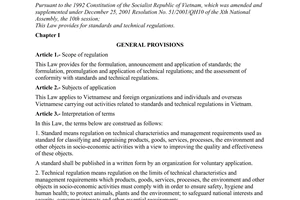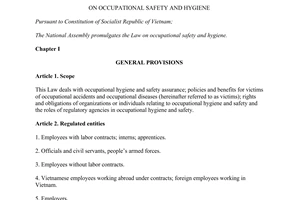Nội dung toàn văn Circular 26/2016/TT-BYT national technical regulation microclimate-permissible value microclimate workplace
|
MINISTRY OF
HEALTH |
SOCIALIST
REPUBLIC OF VIETNAM |
|
No. 26/2016/TT-BYT |
Hanoi, June 30, 2016 |
CIRCULAR
ON NATIONAL TECHNICAL REGULATION ON MICROCLIMATE- PERMISSIBLE VALUE OF MICROCLIMATE IN THE WORKPLACE
Pursuant to the Law No.84/2015/QH13 on Occupational Safety and Hygiene dated June 25, 2015;
Pursuant to the Law No. 68/2006/QH13 on Technical regulations and standards dated June 29, 2006;
Pursuant to the Government's Decree No. 127/2007/ND-CP dated August 01, 2007 detailing the implementation of a number of articles of the Law on Technical regulations and standards;
Pursuant to .the Government's Decree No. 63/2012/ND-CP dated August 31, 2012 defining the functions, rights, responsibilities and organizational structure of the Ministry of Health;
Upon request of the Director of Health Environment Management Agency;
The Minister of Health hereby issues this Circular providing the national technical regulation on microclimate- permissible value of microclimate in the workplace.
Article 1.National technical regulation on microclimate
The national technical regulation (QCVN) 26/2016/BYT on microclimate- permissible value of microclimate in the workplace is enclosed herewith.
Article 2. Effect
This Circular enters into force from December 01, 2016.
Article 3. Implementation
The Director of the Health Environment Management Agency, Directors and Directors General of Departments and General Departments affiliated to the Ministry of Health, Heads of affiliates to Ministries, Directors of the Departments of Health of provinces and direct-controlled municipalities and Heads of health authorities of regulatory authorities shall be responsible for implementation of this Circular ./.
|
|
PP. MINISTER |
QCVN 26:2016/BYT
TECHNICAL REGULATION ON MICROCLIMATE - PERMISSIBLE VALUE OF MICROCLIMATE IN THE WORKPLACE
Foreword
QCVN 26:2016/BYT is compiled by the Compilation Board of the National Technical Regulation on Occupational Hygiene, proposed by the Health Environment Management Agency and issued together with Circular No.26/2016/TT-BYT dated June 30, 2016 by the Minister of Health.
TECHNICAL REGULATION ON MICROCLIMATE - PERMISSIBLE VALUE OF MICROCLIMATE IN THE WORKPLACE
GENERAL PROVISIONS
1. Scope of application
This Regulation stipulates requirements for temperature, humidity, air velocity and heat radiation intensity in the work place.
2. Subject of application
This Regulation applies to Environmental State management authorities, entities monitoring workplace environment; employers whose employees are affected by indoor microclimate in the workplace.
This Regulation shall not apply to the outdoor workplace, construction sites, pits, means of transport and refrigerated warehouses.
3. Interpretation
For the purpose of this Regulation, terms herein shall be construed as follows:
3.1. Microclimate in the workplace is the atmospheric conditions in the workplace, including the combined effects of temperature, humidity, air velocity and surface temperature of utensils and instruments surrounding workers.
3.2. Temperature is a parameter indicating the heat of a physical individual, denoted 0C.
3.3. Humidity:
- Absolute humidity (Ha) is the water content of air at certain time and a given temperature expressed in gram per cubic meter.
- Maximum humidity (Hm) or saturated humidity is the saturated water content of air at certain time and a given temperature expressed in gram per cubic meter.
- Relative humidity (Hr) is the ratio of the absolute humidity to maximum humidity, expressed in percentage.
![]()
3.4. Air velocity is the speed of natural and mechanical air movement in a confined space in the workplace, expressed in m/s.
3.5. Radiant heat is the exchange of thermal energy without the direct contact between particles.
3.6. Light work is a job which involves standing, walking, and sitting and in which a worker is required to frequently use his/her hands most of the time. Light work burns 120 - 150 kcal per hour.
3.7. Medium work is a job which involves standing, walking, moving, processing components weighing less than 1 kg while standing or sitting, and lifting or carrying objects of no more than 10 kg. Medium work burns 151-250 kcal per hour.
3.8. Heavy work is a job and work activity in which a worker is frequently required to carry out while standing or walking, to process and to move objects weighing more than 10 kg. Heavy work burns more than 250 kcal per hour.
3.9. Wet bulb globe temperature (WBGT) is an experimental index of heat stress of an individual exposed.
WBGT index is determined based on two derivative parameters, namely the natural wet-bulb temperature (tnw) and black globe thermometer temperature (tg); in some cases, WBGT is determined based on only dry-bulb temperature (ta).The WBGT index is calculated using the following formula:
- Indoor and outdoor conditions with no solar load:
T°WBGT= 0.7 tnw + 0.3 tg
- Outdoor condition with solar load:
T°WBGT = 0.7 tnw + 0.2 tg + 0.1 ta
II.TECHNICAL SPECIFICATIONS
1. Requirements for microclimatic conditions in the workplace are classified by kind of work as presented in Table 1.
Table 1. Permissible values of microclimate parameters in the workplace
|
Kind of work |
Air temperature (°C) |
Humidity (%) |
Air velocity (m/s) |
Heat radiation intensity by area of exposure (W/m2) |
|
Light work |
20 - 34 |
40 - 80 |
0.1 – 1.5 |
35, when more than 50% of body surface area are exposed 70, when more than 25% up to 50% of body surface area are exposed 100, when less than 25% of body surface area are exposed |
|
Medium work |
18 - 32 |
40 - 80 |
0.2 – 1.5 |
|
|
Heavy work |
16 - 30 |
40 - 80 |
0.3 – 1.5 |
Where the workplace is hot and has high humidity, the air velocity therein may increase to 2 m/s.
Where the workplace having air conditioners and the ventilation is in good condition to ensure the permissible concentration of CO2, the air velocity therein may be less than 0.1 m/s if workers perform light work, less than 0.2 m/s and less than 0.3 m/s if workers perform medium and heavy work, respectively.
The difference in temperature by altitude shall not exceed 3 0C.
The difference in temperature by horizontal direction in the workplace where workers perform light, medium and heavy work shall not exceed 4°C, 5°C and 6°C, respectively. The difference between outdoor temperature and indoor temperature shall not exceed 5°C.
2. Requirements for microclimatic conditions in the workplace by WBGT are presented in the table 2.
Table 2. The permissible value by WBGT
Unit: (°C)
|
Heat exposure duration |
Kind of work |
||
|
Light work |
Medium work |
Heavy work |
|
|
Continuously |
30.0 |
26.7 |
25.0 |
|
75% |
30.6 |
28.0 |
25.9 |
|
50% |
31.4 |
29.4 |
27.9 |
|
25% |
32.2 |
31.4 |
30.0 |
III. MEASUREMENT
The methods for measurement of microclimate in the workplace shall be determined as stipulated in the TCVN 5508 – 2009: workplace air - Microclimate requirement and method for measurement.
IV. MANAGMENT
1. The workplace where workers contact with microclimate elements shall be periodically inspected once every year in accordance with regulations on the Labor Code and Law on Occupational Safety and Hygiene.
2. Employers shall provide their employees with sufficient personal protective equipment which is suitable to use in the workplace under the Law on Occupational Safety and Hygiene.
3. Where any microclimate parameter fails to meet permissible standards, the employer shall take actions for improving the working environment and protecting employees’ health.
V. IMPLEMENTATION
1. This Regulation replaces the Regulation on microclimate in the Occupational Hygiene Regulation enclosed with the Decision No.3733/2002/QD-BYT dated October 10, 2002 by the Ministry of Health.
2. The Health Environment Management Agency- Ministry of Health shall take charge of cooperate with relevant functional authorities to provide guidance and implement this Regulation.
3. The Health Environment Management Agency shall request the Ministry of Health to make proper amendment and supplementation for the purpose of management.
4. In case any of national and international microclimate standards referred to this Regulation is revised, supplemented or replace, the new on shall prevail.





